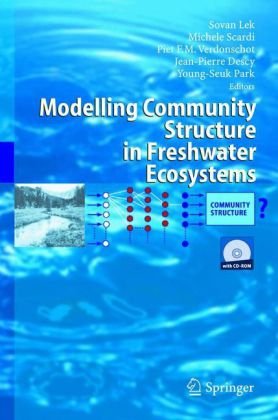

Most ebook files are in PDF format, so you can easily read them using various software such as Foxit Reader or directly on the Google Chrome browser.
Some ebook files are released by publishers in other formats such as .awz, .mobi, .epub, .fb2, etc. You may need to install specific software to read these formats on mobile/PC, such as Calibre.
Please read the tutorial at this link: https://ebookbell.com/faq
We offer FREE conversion to the popular formats you request; however, this may take some time. Therefore, right after payment, please email us, and we will try to provide the service as quickly as possible.
For some exceptional file formats or broken links (if any), please refrain from opening any disputes. Instead, email us first, and we will try to assist within a maximum of 6 hours.
EbookBell Team

4.3
58 reviews
ISBN 10: 3540268944
ISBN 13: 9783540268949
Author: Sovan Lek; Michele Scardi; Piet F.M. Verdonschot; Jean-Pierre Descy; Young-Seuk Park
This volume presents approaches and methodologies for predicting the structure and diversity of key aquatic communities (namely, diatoms, benthic macroinvertebrates and fish), under natural conditions and under man-made disturbance. The intent is to offer an organized means for modeling, evaluating and restoring freshwater ecosystems.
1.Using bioindicators to assess rivers in Europe: An overview
2.Review of modelling techniques
3.Fish community assemblages
4. Patterning riverine fish assemblages using an unsupervised neural network
5. Predicting fish assemblages in France and evaluating the influence of their environmental variables
6. Fish diversity conservation and river restoration in southwest France: a review
7. Modelling of freshwater fish and macro-crustacean assemblages for biological assessment in New Zealand
8. A comparison of various fitting techniques for predicting fish yield in Ubolratana reservoir (Thailand) from a time series data
9. Patterning spatial variations in fish assemblage structures and diversity in the Pilica River system
10. Optimisation of artificial neural networks for predicting fish assemblages in rivers
11. Sensitivity and robustness of a stream model based on artificial neural networks for the simulation of different management scenarios
12. A neural network approach to the prediction of benthic macroinvertebrate fauna composition in rivers
13. Predicting Dutch macroinvertebrate species richness and functional feeding groups using five modelling techniques
14. Comparison of clustering and ordination methods implemented to the full and partial data of benthic macroinvertebrate communities in streams and channels
15. Prediction of macroinvertebrate diversity of freshwater bodies by adaptive learning algorithms
16. Hierarchical patterning of benthic macroinvertebrate communities using unsupervised artificial neural networks
17. Species spatial distribution and richness of stream insects in south-western France using artificial neural networks with potential use for biosurveillance
18. Patterning community changes in benthic macroinvertebrates in a polluted stream by using artificial neural networks
19. Patterning, predicting stream macroinvertebrate assemblages in Victoria (Australia) using artificial neural networks and genetic algorithms
20. Applying case-based reasoning to explore freshwater phytoplankton dynamics
21. Modelling community changes of cyanobacteria in a flow regulated river by means of a Self-Organizing Map (SOM)
22. Use of artificial intelligence (MIR-max) and chemical index to define type diatom assemblages in Rhône basin and Mediterranean region
23. Classification of stream diatom communities using a self-organizing map
24. Diatom typology of low-impacted conditions at a multi-regional scale: combined results of multivariate analyses and SOM
25. Prediction with artificial neural networks of diatom assemblages in headwater streams of Luxembourg
26. Use of neural network models to predict diatom assemblages in the Loire-Bretagne basin (France)
27. Evaluation of relevant species in communities: development of structuring indices for the classification of communities using a self-organizing map
28. Projection pursuit with robust indices for the analysis of ecological data
29. A framework for computer-based data analysis and visualisation by pattern recognition
30. A rule-based vs. a set-covering implementation of the knowledge system LIMPACT and its significance for maintenance and discovery of ecological knowledge
31. Predicting macro-fauna community types from environmental variables by means of support vector machines
32. User interface tool
33. General conclusions and perspectives
model communities association
model of a community
structure models describe the
community-based model
community building models
Tags: Sovan Lek, Michele Scardi, Piet Verdonschot, Community